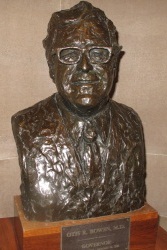
Governor of Indiana
- Indiana State Representative
- Indiana Speaker of the House
- U.S. Secretary of Health and Human Services
Bust Location
Statehouse Rotunda, 3rd floor, Facing east, north corner
Born
Fulton County
Lived
Bremen
Otis R. Bowen was born on February 26, 1918 in Fulton County, Indiana. He attended local schools, graduating from Francesville High School in 1935. Bowen went on to enroll in a three-year pre-med program at Indiana University, where he worked many odd jobs in order to finance his education. In the summer between his sophomore and junior years, Bowen spent the summer in Crown Point, Indiana, where he met Elizabeth Anna Agnes Steinmann. Only five weeks after they first met, the two were engaged, though they waited until February 25, 1939 to get married, when Bowen had finished with his program at IU. Following his graduation, Bowen interned at a hospital in South Bend until he entered active duty on July 3, 1943. Following the end of WWII, Bowen returned to Bremen, Indiana, where he started a private medical practice.69
Bowen’s interest in politics began soon after he opened his private practice. In 1952, Bowen ran for Marshall County Coroner, and he won the position. Four year later, Bowen decided to run for his district’s seat in the Indiana House of Representatives. After receiving the Republican Party nomination, Bowen was elected to the position over the Democratic opponent. In 1958, Bowen failed to be re-elected to his seat, losing the popular election by only four votes. Two years later, he ran again and won his seat back. The election of 1960 would be the first of seven consecutive House terms that he would serve.70
While serving his district in the Indiana General Assembly, Bowen continually increased his prominence within the Republican Party. In 1965, he became the minority party leader. When the Republicans gained the majority the next year, Bowen was officially made the Speaker of the House in 1967. He served in the position for four legislative sessions, though he already had aspirations to serve as Indiana’s chief executive. In 1968, Bowen was unsuccessful in seeking the Republican nomination for governor. After four years of serving as the Speaker of the House, Bowen easily earned his party’s nomination in 1972, and went on to win the election. That same year, voters ratified an amendment to the state constitution which allowed governors to serve two consecutive terms. In 1976, Bowen became the first governor since 1851 to serve two consecutive terms in the office.71
As governor, Bowen had multiple successes for which he is remembered. During his first term, in 1973, he created a tax restructuring plan which passed through the legislature. The tax package would not be altered for decades. One of Bowen’s main concerns was the statewide emergency medical system (EMS). In the same year that he passed his tax package, Bowen convened a Governor’s conference on EMS, the result of which brought significant changes to the system. The accomplishment of which Bowen is the most proud was his upgrading of the state park and recreation system. While in office, he helped to create five new state parks, including the White River State Park in Indianapolis, which was the first urban park of Indiana. During his second term, Bowen helped to reorganize the State Highway Department, combining it with a number of other agencies to create the Indiana Department of Transportation. One of Bowen’s greatest legacies was the passing of legislation that limited medical malpractice claims to $500,000. In 1981, Bowen left the office of Governor, handing over the position to his Lieutenant Governor Robert D. Orr.72
After leaving office, Bowen became a professor of medicine and director of undergraduate family practice education at the Indiana University Medical Center.73 In 1985, he was nominated to be the Secretary of Health and Human Services, a cabinet position within the administration of Ronald Reagan. His nomination was successfully confirmed by the U.S. Senate soon after, and Bowen took charge of running a government agency with a $330 billion budget, 130,000 employees and 250 programs.74 Bowen remained the head of the agency until January 20, 1989, when President Reagan left office. Following that, Bowen retired to Bremen.75
Bust History
The original clay model for this bust was created by Lou Ann Lanagan in 1981. Using that model, Lanagan created three bronze busts. Each includes both Lanagan’s and Bowen’s signatures in the back, along with the date. One bust was donated to the Indiana Statehouse soon after it was created. The second copy was a gift to Bethel College, which is Bowen’s alma mater. Lanagan held onto the other bust until donating it to the Archives and Special Collection Research Center of Ball State University. BSU holds an annual meeting, the Bowen Institute on Political Participation, and the bust was donated on the Institute’s 25th year.76 The bust at the Statehouse is located on the third floor, in a niche outside of the Rotunda, on the east side.
Sculptor
Lou Ann Lanagan
Lou Ann Lanagan was not professionally trained as an artist. She took up the craft of sculpting after seeing her dentist work with molding patients’ teeth. He challenged her to create a bust out of clay, and she created her first bust of her husband. Since that time, Lanagan has created the busts of a number of prominent individuals, including Eli Lilly.77
69Scheele, Raymond H. “Otis R. Bowen” in Governors of Indiana. Indianapolis: Indiana Historical Society Press, 2006. p 360-362.
70 Ibid. p 362-363.
71 “Otis R. Bowen.” Governor Daniels - Previous Governors. 2011. http://www.in.gov/2347.htm.
72 Scheele, Raymond H. p 364-365.
73 “Otis R. Bowen.”
74 “Small-Town Doctor, Big-Time Challenge.” The New York Times. November 9, 1985.
75 “Otis R. Bowen.”
76 Kinney, Jeremiah S. “University Libraries Receives Bowen Bust.” The Library Insider. January 2006.
77 “Otis Bowen (bust).” http://en.wikipedia.org/wiki/Otis_Bowen_%28Lanagan%29.
